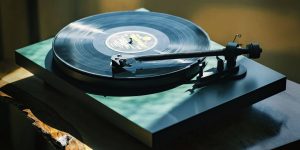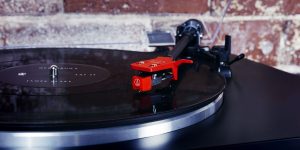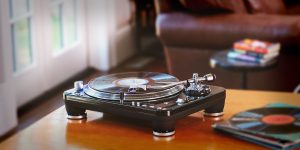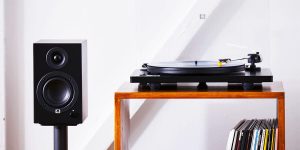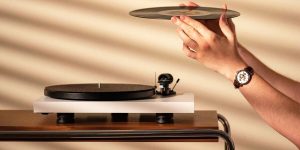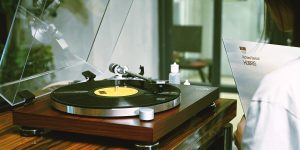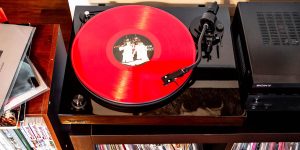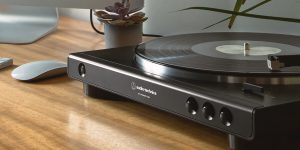As I’m sure you know, selecting the right speakers for your turntable directly impacts your music’s clarity and depth. In this review, I will tell you about the main things you need to consider when choosing equipment (namely speakers) to enhance the sound quality of your vinyl. I aim to simplify your search for the best speakers for your record player so that your favorite music sounds as good as possible. And, of course, taking into account my wide audience, I have selected budget, mid-range, and fairly high-end options. Choose what’s right for you.
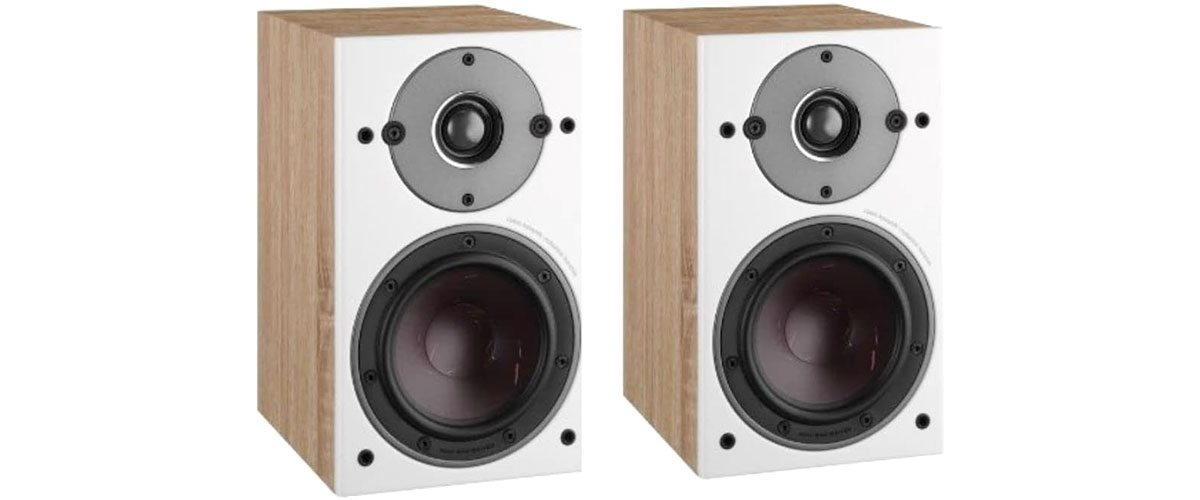
Speakers for record player comparison table
| Name | Power type | Output peak power | Speakers type | Frequency response | Sensitivity | Review |
|---|---|---|---|---|---|---|
| DALI Oberon 1 best overall | active | 100W | woofer | 51Hz-26kHz | 86dBA | Review |
| Edifier R1280T budget | active | 42W | bookshelf | 52Hz-20kHz | 85dBA | Review |
| Sonos Five smart option | active | 120W | woofer,tweeter | 50Hz-25kHz | 85dBA | Review |
| Klipsch RP-600M passive speakers | passive | 400W | bookshelf, woofer | 45Hz-25kHz | 96dBA | Review |
| Fluance Ai81 floorstanding | active | 150W | floorstanding | 30Hz-20kHz | 12dBA/Oct | Review |
Best speakers for record player reviews
DALI Oberon 1 – best overall

Having tested the DALI Oberon 1 bookshelf speakers, I must say they’ve been quite the conversation piece in my office. Known for their reputation, DALI didn’t disappoint with these little marvels. They’re like the compact car that surprisingly packs a punch under the hood – small but mighty.
First off, these speakers are pretty unassuming in appearance, about the size of a shoebox, and stick to a traditional design. But it’s the subtleties that DALI has nailed. The tweeter, for one, is slightly larger than what you’d find in the competition. This might not sound like much, but it allows for a crisper, more integrated sound that really brings out the nuances in your vinyl collection, making them the best speakers for a turntable setup in their range.
The build quality is solid. With an MDF cabinet that feels robust and comes in four different finishes, it’s easy to match them to your room’s aesthetic. Their size makes them versatile for placement, though I found pulling them a bit away from the wall significantly improved their stereo imaging and clarity – something to keep in mind for keen listeners looking to squeeze out every bit of quality.
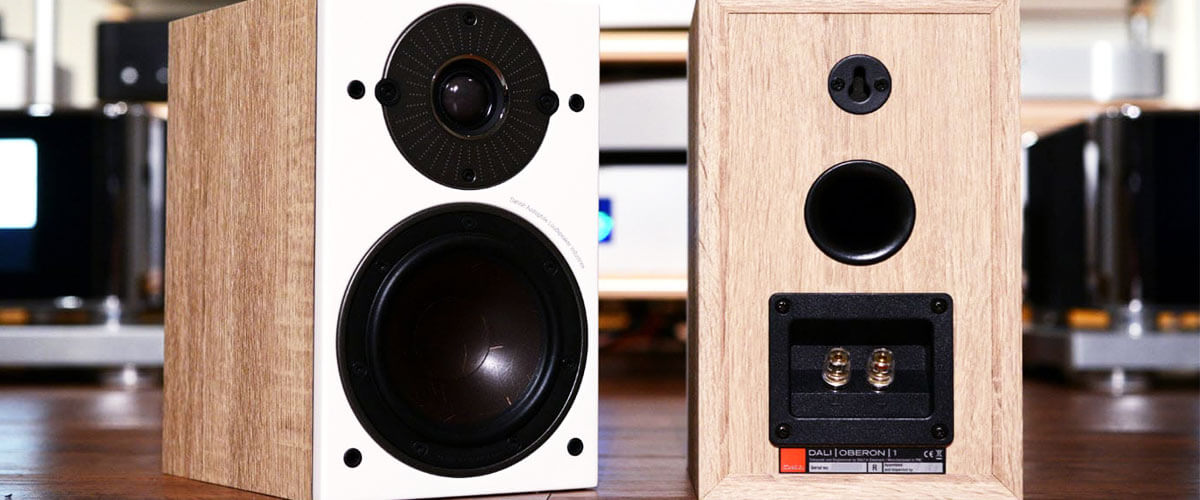
Now, don’t expect ground-shaking bass from these speakers – physics has its limits. However, the bass they do provide is articulate and, frankly, impressive for their size. Where the Oberon 1s really shine is in their midrange clarity and vocal performance. Listening to Tracy Chapman’s “Telling Stories,” the speakers delivered her voice with such raw emotion and depth it was hard not to get drawn in.
In conclusion, while the DALI Oberon 1s may not outperform larger, more expensive counterparts in every aspect, their ability to deliver a balanced, expressive soundstage from such a compact design is genuinely impressive. These powered speakers are a testament to DALI’s engineering prowess and an optimal choice for anyone looking to enhance their turntable experience without dominating their living space.
Key specs
- Power type: active.
- Output peak power: 100W.
- Speakers type: woofer.
- Frequency response: 51Hz-26kHz.
- Sensitivity: 86dBA.
- Connectivity: wired, wireless (Bluetooth).
- Dimensions, inch/cm: 10.6×6.3×9.2/27.4×16.2×23.4.
- Weight, lb/kg: 9.2/4.2.
Pros
- Compact size – versatile placement.
- High build quality – solid MDF cabinet.
- Improved tweeter design – the larger-than-average tweeter allows for a crisp, integrated sound that enhances overall audio quality.
Cons
- Bass limitations – while articulate, the speakers’ compact size limits the bass output.
Edifier R1280T – budget
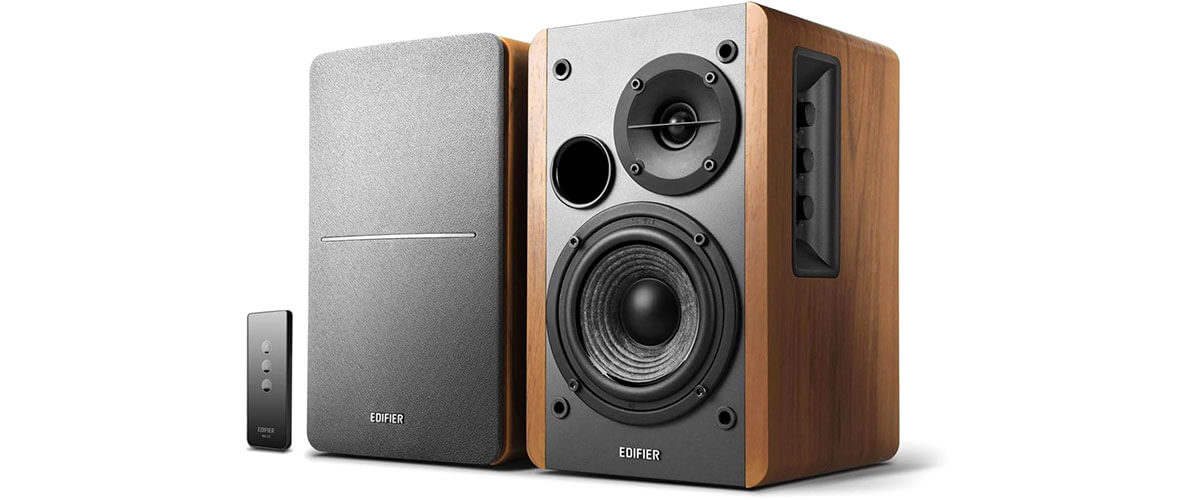
When I unboxed the Edifier R1280T, I was genuinely curious to see if they lived up to the buzz as the best budget speakers for turntable aficionados. Right off the bat, their classic wood finish caught my eye – these speakers really have a way of making your space look more refined without trying too hard.
Now, let’s get down to brass tacks. The sound? It’s decent. We’re not talking ground-breaking clarity or depth that’ll have audiophiles dropping their jaws, but for the price point, I was nodding along to my favorite tracks with a satisfied grin. These bookshelf speakers hit that sweet middle ground – good enough for most casual vinyl lovers.
Volume-wise, these little guys can pack a punch. Filling up my little office with sound wasn’t an issue, but I did notice they start to show their limits when you really crank it up – the bass gets boisterous, overshadowing mids and highs. With some tweaking, though, you can find a more balanced sound that suits your taste.
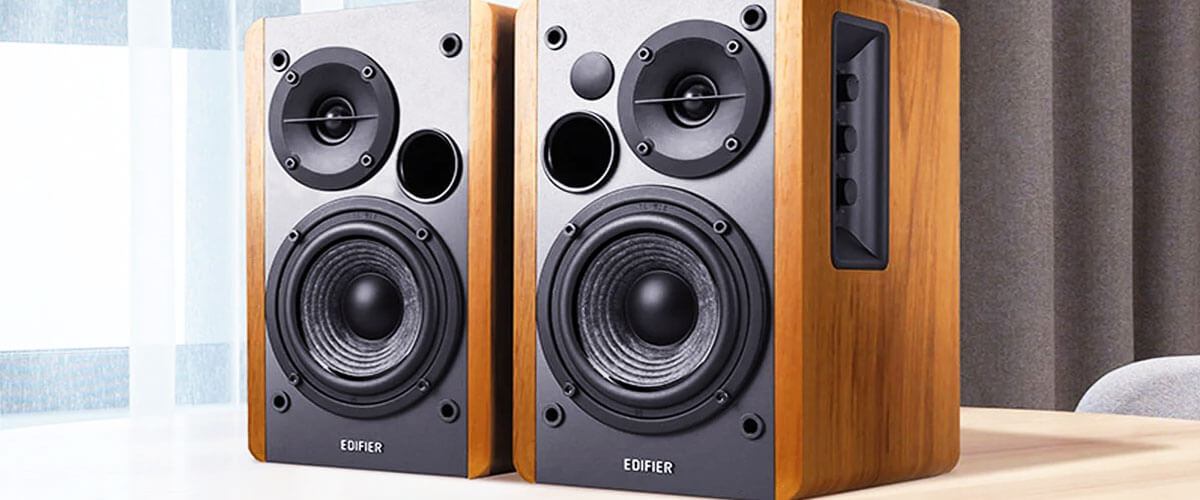
Placement is important. Initially, I had them sitting directly on my desk, which was a mistake. The sound felt somewhat hollow, lacking that oomph. Elevating them to ear level made a world of difference – the music suddenly had more body, more life.
And, oh, the on/off switch at the back? A bit of a quirky choice. It’s not a deal-breaker, but it’s something you’ll notice when you’re reaching around to power the monitors up or down.
Wrapping things up, Edifier R1280T encapsulates what it means to enjoy music on a budget, offering a satisfying listening experience that’s hard to beat at this price point.
Key specs
- Power type: active.
- Output peak power: 42W.
- Speakers type: bookshelf.
- Frequency response: 52Hz-20kHz.
- Sensitivity: 85dBA.
- Connectivity: wired, wireless (Bluetooth).
- Dimensions, inch/cm: 9.5×5.7×6.5/24.1×14.5×16.5.
- Weight, lb/kg: 10.8/4.9.
Pros
- Feel solid.
- Classic wood finish – adds an aesthetic appeal that mimics traditional high-quality wood designs.
- Adequate sound.
- Include a remote control.
Cons
- Can fill a room at moderate volumes, but pushing them too hard leads to distortion.
- Placement sensitivity – optimal sound quality is achieved when the speakers are at ear level, as placement below this can result in a diminished audio experience.
- The placement of the on/off switch on the back is a minor inconvenience, potentially making it harder to access depending on the speakers’ location.
Sonos Five – smart option
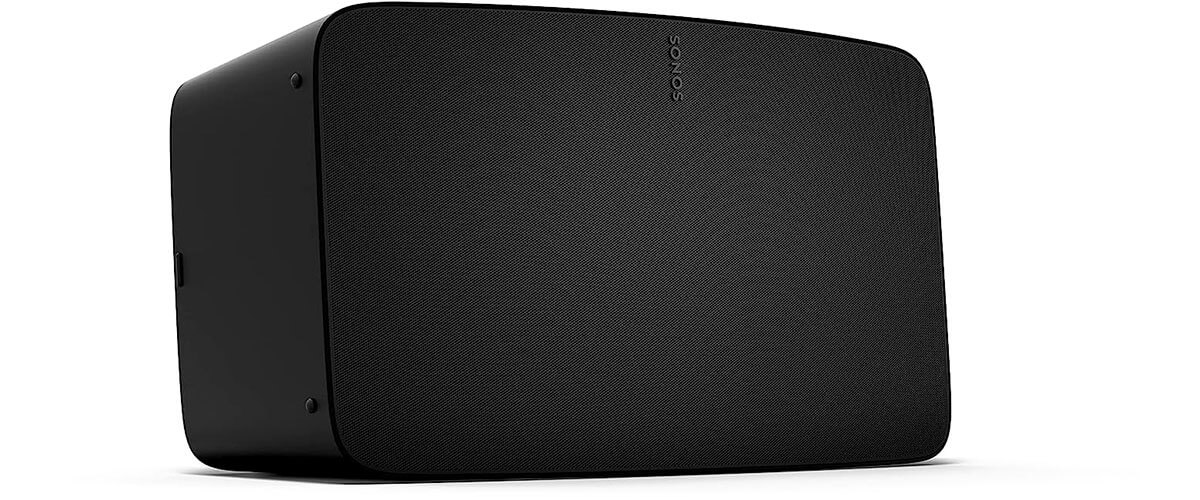
Having spent some time with the Sonos Five, I’ve come to appreciate its place in the storied lineage that stretches back to the original S5. On the surface, it might just look like another sleek piece of Sonos’ craftsmanship, but delve a little deeper, and you’ll find it’s much more than that.
The aesthetic is classic Sonos: understated yet elegant, with a solid build that feels like it’s meant to last. Available in either matte black or white, it’s got a look that can blend into any decor without missing a beat. Designed to perform in both landscape and portrait orientations, it’s clear that versatility is a key aspect of its design ethos.
The sound setup in the Sonos Five is ambitious, featuring six Class D amplifiers powering a trio of mid/bass units and three tweeters. This arrangement aims for an expansive sound spread, and in my experience, it does not disappoint. Straight out of the gate, the bass is punchy, perhaps too much. However, after running the TruePlay tuning (a nod to iOS users, as Android folks are left out of this acoustic optimization), the speaker finds its balance, offering a rich, detailed sound that’s hard to fault.
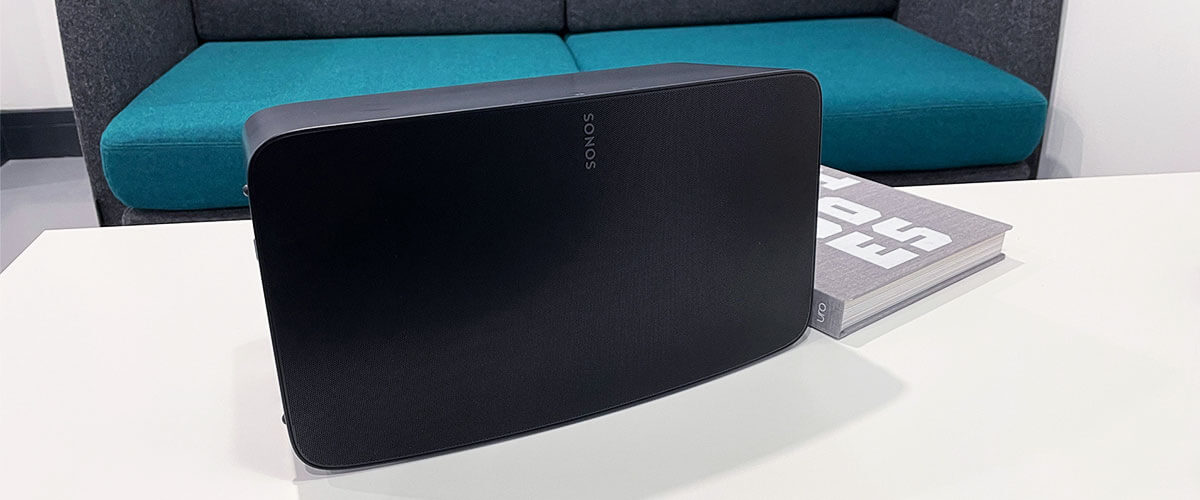
Connectivity is where the Sonos Five sticks to its guns, eschewing Bluetooth for a more Sonos-centric ecosystem approach with Apple AirPlay 2 and physical inputs. It’s a choice that might not suit everyone, especially those looking for Bluetooth simplicity.
Using the Sonos app is a breeze, making it easy to adjust settings, integrate into a multi-room setup, or play around with the EQ. The absence of built-in mics means no native voice control, but it’s a small price to pay for the quality and depth of sound on offer.
Wrapping up, for those with a keen eye for modern technology and a soft spot for the Sonos ecosystem, this model clearly stands out as one of the best speakers for vinyl, blending today’s tech with yesterday’s classic tunes seamlessly.
Key specs
- Power type: active.
- Output peak power: 120W.
- Speakers type: woofer,tweeter.
- Frequency response: 50Hz-25kHz.
- Sensitivity: 85dBA.
- Connectivity: wired, wireless (Bluetooth).
- Dimensions, inch/cm: 8.0×14.3×6.0/20.3×36.4×15.4.
- Weight, lb/kg: 13.9/6.3.
Pros
- Minimalistic, modern look.
- Decent sound.
- Capable of significant volume without altering its sonic characteristics.
- Has a 3.5-mm analog input.
Cons
- Lacks Bluetooth.
- TruePlay calibration is limited to iOS.
- No built-in voice control – requires an additional Sonos product with a microphone for voice commands.
Klipsch RP-600M – passive speakers
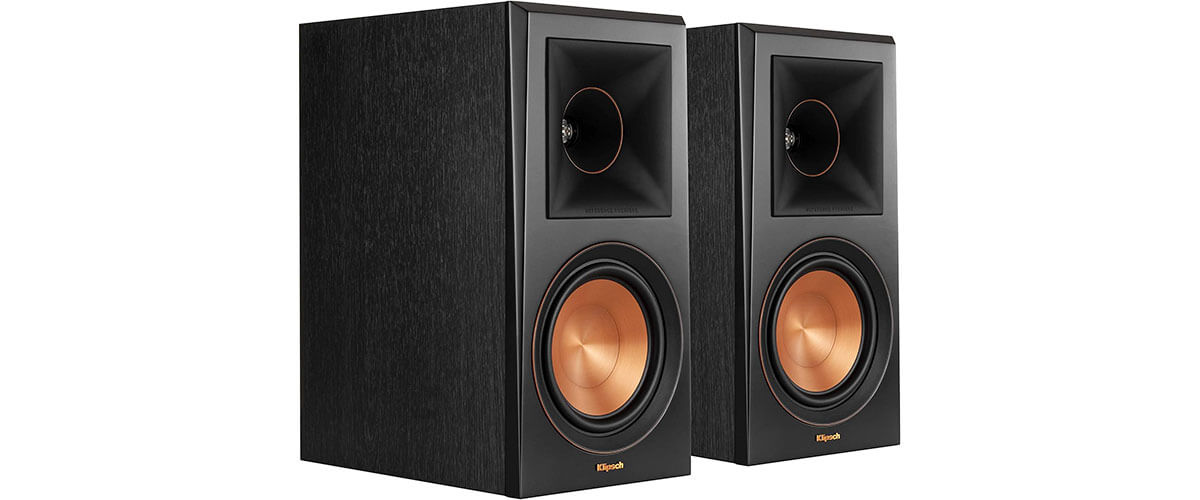
Testing the Klipsch RP-600M, I met a blend of the conventional and the distinctive – a hallmark of Klipsch’s approach to speaker design. At first glance, the RP-600M presents itself as a standard fare in the crowded mid-range passive speakers market. Yet, its performance and design nuances tell a different story, particularly compelling for vinyl enthusiasts.
Standing modestly with its two-way, ported standmount design, the RP-600M doesn’t scream for attention, yet its aesthetic choices in ebony and walnut finishes add a touch of class to any room. While not the most robust I’ve encountered, the build holds its own, with a lightweight yet decently finished cabinet that resonates with Klipsch’s quality standards.
What sets the RP-600M apart is its sound delivery. Powered by the hybrid Tractrix horn-loaded tweeter and the Cerametallic bass/mid driver, it brings a lively, energetic sound that grabs you. The bass is punchy, giving tracks a sense of immediacy and presence that’s hard to ignore. This speaker has a way of making you sit up and take notice, especially with genres that thrive on a bouncy, zestful sound profile.
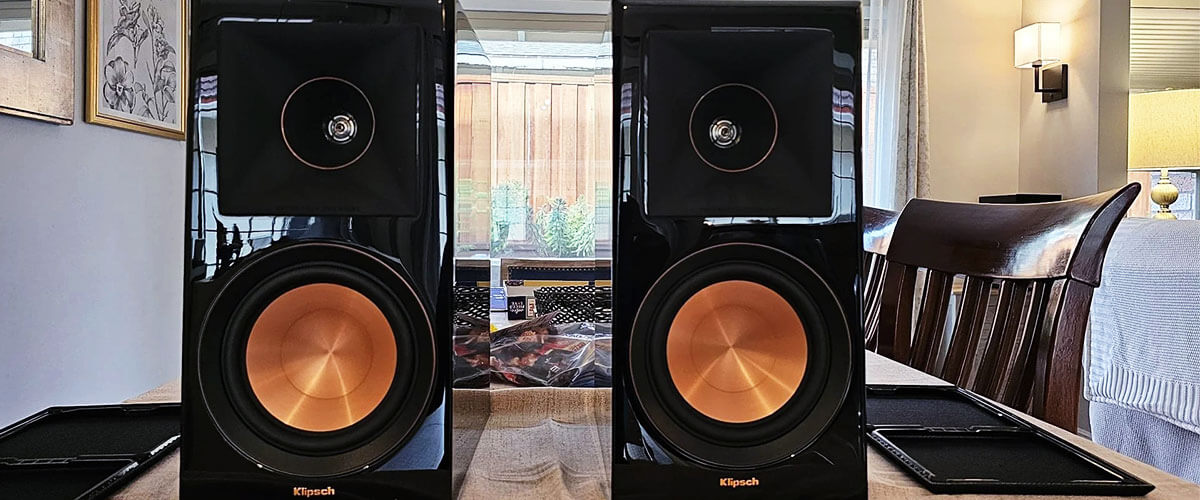
However, it’s not without its quirks. The RP-600M tends to emphasize the upper bass, which can occasionally overshadow the finer details in more nuanced recordings. While generally delivering clarity, the tweeter edges into harshness at times, a reminder of its ‘boom ‘n tizz’ lineage.
Positioning these speakers requires a bit of finesse. Keeping it away from boundary walls and opting for a slight toe-in can significantly enhance its bass performance and stereo imaging. It’s not fussy about amplification, performing admirably with solid-state and valve amps, which is a testament to its versatility.
In summary, the Klipsch RP-600M emerges as a notable choice among passive speakers for vinyl, blending a unique sound signature with practical design elements. Its energetic performance and thoughtful engineering cater well to those seeking vibrancy and depth in their music collection despite minor quirks in sound balance.
Key specs
- Power type: passive.
- Output peak power: 400W.
- Speakers type: bookshelf, woofer.
- Frequency response: 45Hz-25kHz.
- Sensitivity: 96dBA.
- Connectivity: coaxial.
- Dimensions, inch/cm: 15.7×7.9×11.8/39.9×20.2×30.1.
- Weight, lb/kg: 16/7.3.
Pros
- Beautiful design.
- Well-suited for upbeat genres like rock, pop, and R&B.
- Bi-wirable binding posts – add flexibility for users looking to customize their audio setup.
Cons
- Less sturdy than some competitors.
- Might not appeal to those with a preference for jazz or classical music.
Fluance Ai81 – floorstanding
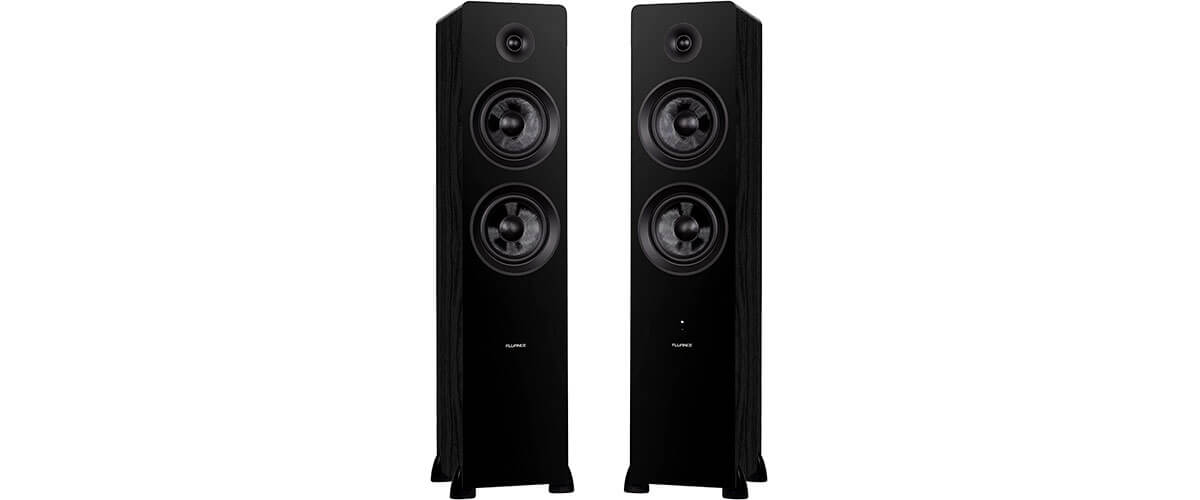
These floorstanding speakers have a presence in the room – not just physically but sonically too. They’re tall, with a sleek design that blends well, whether you’re going for a modern vibe or something more classic. But let’s dive into what really matters: how they perform.
Right out of the box, the build quality of the Ai81s feels solid. They’re not too heavy, but they’ve got enough heft to assure you they won’t dance off the stand with every bass note. Speaking of bass, the down-firing port on these babies does a decent job. It won’t shake your floorboards like a dedicated subwoofer, but it’s pretty respectable for built-in bass.
Now, about that sound. Powered by an internal 150-watt Class D amp, these speakers can fill a room. Thanks to that 1-inch silk dome tweeter, the highs are crisp, and the mids come through clear. However, the bass, while present, lacks a bit of depth. It’s there and noticeable, but for my taste, I wanted just a bit more punch.
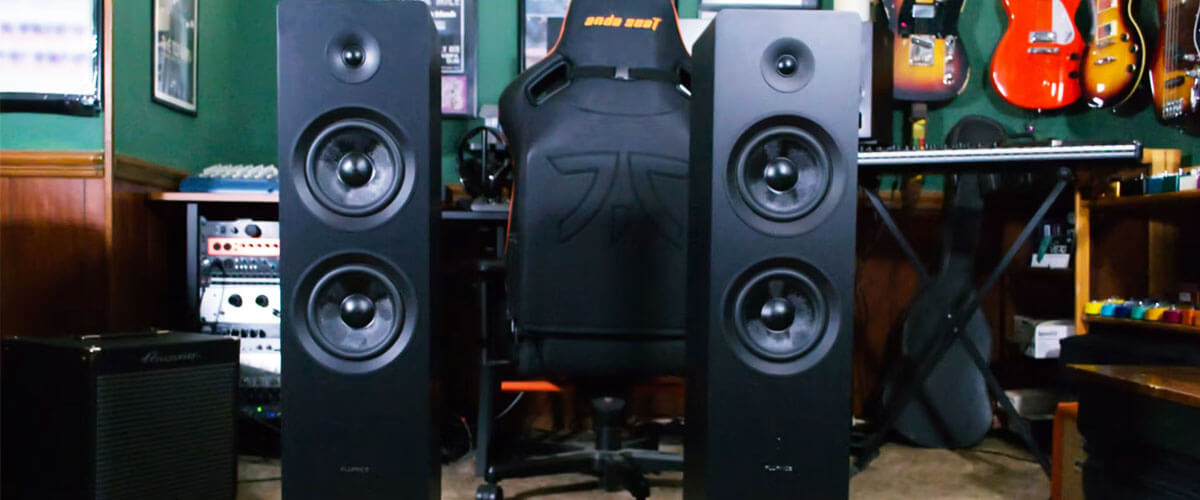
Connectivity is where the Ai81s really shine. With options for optical Toslink, analog RCA, and Bluetooth 5.0, you’ve got a lot of flexibility. I particularly appreciated the Bluetooth connection – it’s stable and quick to connect. The lack of Wi-Fi or smart features might be a miss for some, but honestly, with the way these speakers handle everything else, I didn’t find myself missing it too much. Although I think for a modern gadget, such an option as Wi-Fi should definitely be present.
One thing that bugged me was the length of the included speaker wire and optical cable. If you’ve got a big room or an intricate setup, you might need to invest in some longer cables.
In wrapping up, the Fluance Ai81s are a solid choice for someone looking to upgrade their home audio without diving too deep into their pockets. These speakers offer good sound, plenty of connectivity options, and a design that should fit most spaces. While they won’t blow discerning audiophiles away, they’re a respectable option for the price.
Key specs
- Power type: active.
- Output peak power: 150W.
- Speakers type: floorstanding.
- Frequency response: 30Hz-20kHz.
- Sensitivity: 12dBA/Oct.
- Connectivity: wired, wireless (Bluetooth).
- Dimensions, inch/cm: 37.8×8.5×10.2/96×21.6×26.
- Weight, lb/kg: 30.6/13.8.
Pros
- Good, detailed sound.
- Substantial volume.
- Flexible connectivity options.
Cons
- The provided speaker wire and optical cable lengths may pose setup challenges.
- No Wi-Fi.
Factors to consider when choosing speakers for vinyl
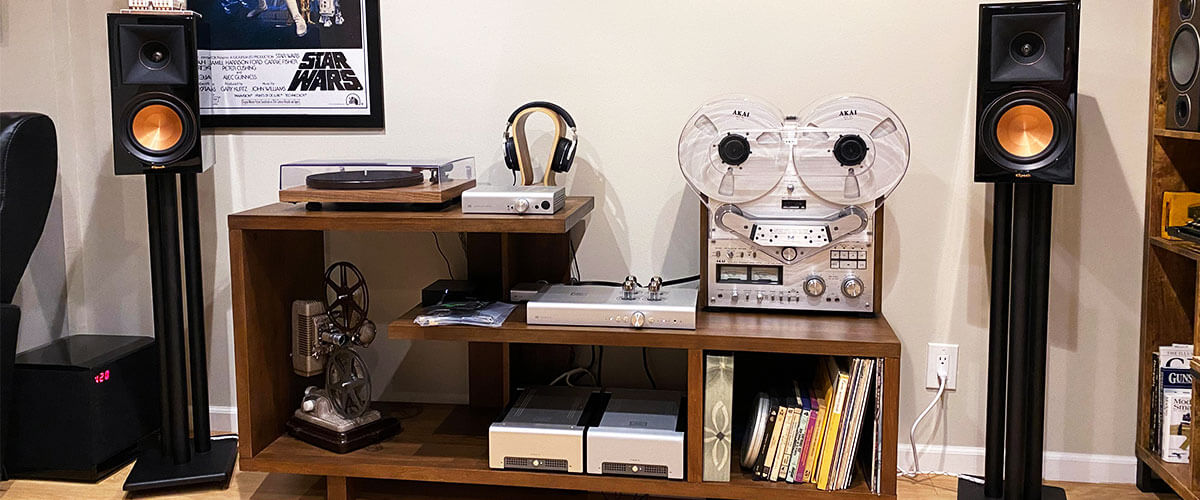
In this section, I’ll explain what factors to consider when shopping around for speakers. So, let’s break down what you need to know.
Active vs. passive speakers
The choice between active and passive speakers can make a huge difference in your setup. Active speakers, also known as powered speakers, have built-in amplifiers. This means you can connect them directly to your turntable, provided it has a preamp, or to an external preamp without needing a separate amplifier. They’re incredibly convenient and can save space, making them a solid choice for those who prefer a straightforward setup.
On the flip side, passive speakers require an external amplifier or receiver to drive them. This extra step allows for more customization, leading to higher audio quality, as you can mix and match dynamics with amplifiers to find your perfect sound. While it might seem daunting at first, the flexibility and potential for an upgraded listening experience make passive speakers a favorite among audiophiles like myself.
Choosing between active and passive gear comes down to what you value more: convenience and simplicity or the ability to fine-tune your sound and upgrade components over time.
Bookshelf speakers vs. floorstanding speakers

Deciding between the bookshelf and floorstanding speakers is a pivotal moment in setting up your vinyl listening space. Bookshelf speakers, compact and versatile, fit beautifully into more intimate spaces or alongside a crowded desk. Their size belies their power, often delivering sound that’s rich in detail and warmth, perfect for those who savor the intricate layers of their favorite tracks.
Contrastingly, floorstanding speakers stand tall, commanding presence and space. They’re built to fill larger areas with robust, enveloping sound, thanks to their ability to house multiple drivers that enhance everything from the deepest bass to the crispest highs.
My own experiences have taught me that whether you’re in a snug spot looking for something that fits just right or you’ve got room to fill and crave that full, live performance feel, there’s no wrong choice. It all comes down to what makes you happy when you drop that needle and lose yourself in the music.
Sensitivity
Sensitivity in speakers is a bit like a person’s hearing acuity – it tells you how effectively a speaker converts power into sound. Measured in decibels (dB), this figure can tell you how loud a dynamic will get with a given amount of power. A higher sensitivity rating, say around 90dB or more, means less power is needed to produce high volumes, making these speakers energy-efficient pals for your turntable. Understanding this can help you match monitors with your amplifier or receiver perfectly, ensuring your vinyl setup is as harmonious as your favorite album.
Impedance
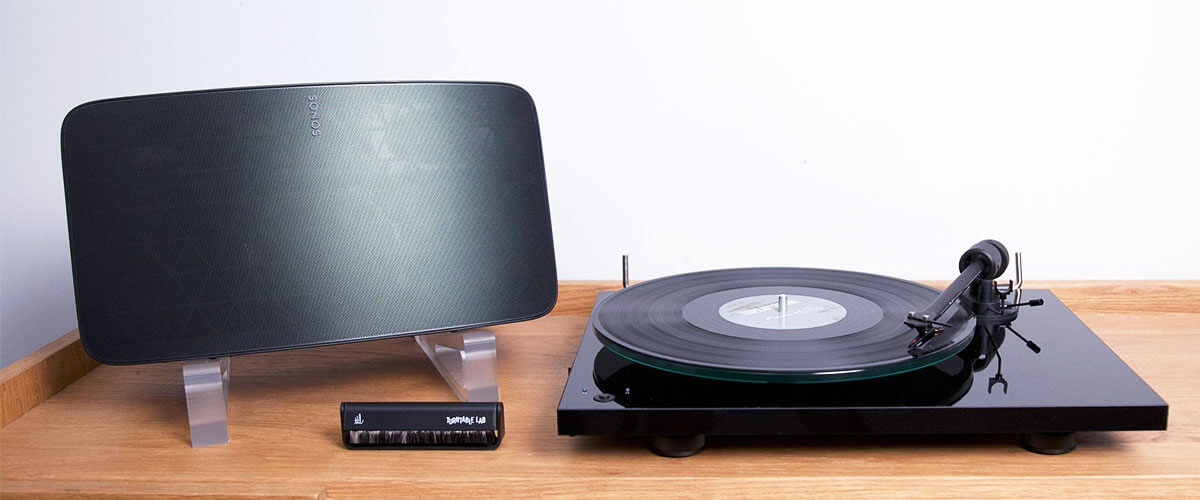
Impedance is one of those technical terms that sounds more intimidating than it actually is. Think of it as the electrical resistance your speakers offer to the amplifier’s signal. Measured in ohms, it’s an important piece to the puzzle in ensuring your speakers and amplifier are compatible. Most home speakers fall into the 4 to 8-ohm range, which suits the majority of amplifiers and receivers.
Why does this matter for your vinyl setup? Matching the impedance between your monitors and amp ensures efficient power transfer, reducing strain on both components. From my tinkering with different setups, I’ve found that keeping an eye on impedance can save you from unnecessary headaches, ensuring your system works together seamlessly.
Frequency response
Frequency response is the range of sound frequencies a speaker can reproduce, typically measured in hertz (Hz). It gives you a snapshot of how well a speaker can handle the lows, mids, and highs of your music. A wide frequency range, for instance, 20 Hz to 20 kHz, suggests a speaker can cover everything from the deep bass of a kick drum to the high pitch of a cymbal crash, delivering more detailed and lifelike sound.
However, it’s not just about the numbers – how smoothly a dynamic handles the transitions between frequencies matters too. Some speakers may boast a wide range but struggle with certain tones. That’s why, alongside checking the specs, listening to how a speaker performs across different genres of music can reveal a lot about its quality and whether it will suit your vinyl adventures.
We are supported by our audience. When you purchase through links on our site, we may earn an affiliate commission at no extra cost to you.
Our newsletter
* We will never send you spam or share your email with third parties

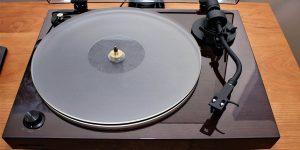

![Best Turntables Under $100 [Reviewed and Tested]](https://righttechadvice.com/wp-content/uploads/2023/09/best-turntable-under-100-300x150.jpg)
![Best Turntables Under $300 [Reviewed and Tested]](https://righttechadvice.com/wp-content/uploads/2023/10/best-turntable-under-300-review-300x150.jpg)
![Best Record Players Under $200 [Reviewed and Tested]](https://righttechadvice.com/wp-content/uploads/2023/10/best-turntable-under-200-300x150.jpg)
